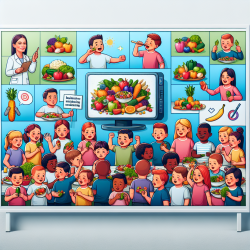Introduction
In the realm of child development and nutrition, mass media interventions hold significant potential to influence positive behavior changes. The research article "Factors influencing the uptake of a mass media intervention to improve child feeding in Bangladesh" provides valuable insights into how media campaigns can effectively promote child feeding practices. As practitioners in the field of speech-language pathology, understanding and leveraging these insights can enhance our approaches to improving children's outcomes.
Understanding the Research
The study conducted in Bangladesh aimed to examine the factors influencing the uptake of infant and young child feeding messages promoted through TV spots. The research utilized a mixed-methods approach, involving household surveys and semi-structured interviews with mothers and other household members. The results indicated that exposure to TV spots ranged from 36% to 62%, with comprehension levels varying from 33% to 96% among viewers.
Key factors associated with comprehension included younger maternal age and receipt of home visits by frontline health workers. The study also highlighted that direct narrative spots were more effective in message recall and believability compared to metaphorical and indirect narratives.
Implications for Practitioners
For practitioners in speech-language pathology and related fields, the findings from this study offer several actionable insights:
- Targeted Messaging: Craft messages that are direct and easy to comprehend. Avoid complex metaphors that may confuse the audience, especially when addressing diverse populations.
- Engagement with Younger Mothers: Recognize the role of younger maternal age in message comprehension. Tailor interventions to engage this demographic effectively, potentially through digital platforms they frequent.
- Collaborate with Health Workers: Partner with frontline health workers to reinforce messages through home visits and community outreach. This dual approach can enhance the effectiveness of media campaigns.
Encouraging Further Research
While the study provides a robust foundation, further research is essential to explore the nuances of media interventions in different cultural contexts. Practitioners are encouraged to consider the following areas for future investigation:
- Explore the impact of digital media platforms, such as social media and mobile apps, on child nutrition education.
- Investigate the long-term effects of media interventions on child feeding practices and overall health outcomes.
- Examine the role of community-based participatory approaches in designing and implementing media campaigns.
Conclusion
By integrating the insights from this research into our practice, we can better support the nutritional needs of children and foster healthier communities. The power of mass media, when harnessed effectively, can drive significant improvements in child feeding practices. As practitioners dedicated to creating positive outcomes for children, let us embrace data-driven approaches and continue to innovate in our strategies.
To read the original research paper, please follow this link: Factors influencing the uptake of a mass media intervention to improve child feeding in Bangladesh.










